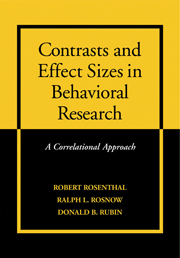
-
Select format
-
- Publisher:
- Cambridge University Press
- Publication date:
- 18 April 2011
- 28 December 1999
- ISBN:
- 9780511804403
- 9780521652582
- 9780521659802
- Dimensions:
- (253 x 177 mm)
- Weight & Pages:
- 0.64kg, 224 Pages
- Dimensions:
- (253 x 177 mm)
- Weight & Pages:
- 0.446kg, 224 Pages
You may already have access via personal or institutional login
Book description
Contrasts are statistical procedures for asking focused questions of data. Compared to diffuse or omnibus questions, focused questions are characterized by greater conceptual clarity and greater statistical power when examining those focused questions. If an effect truly exists, we are more likely to discover it and to believe it to be real when asking focused questions rather than omnibus ones. Researchers, teachers of research methods and graduate students will be familiar with the principles and procedures of contrast analysis, but will also be introduced to a series of newly developed concepts, measures, and indices that permit a wider and more useful application of contrast analysis. This volume takes on this new approach by introducing a family of correlational effect size estimates.
Reviews
‘A milestone. Contrasts and Effect Sizes in Behavioural Research is bound to remain the definitive word on contrast analysis for many years to come.’
Miron Zuckerman - University of Rochester
‘Contrasts and Effect Sizes in Behavioural Research … is a masterpiece of careful exposition. It introduces a framework and terminology for thinking of concepts that will be familiar to anyone who has struggled with the issues of how to represent effects in diverse research literatures, e.g., anyone who has ever done a mata-analysis. It fills a nees that I and others have observed over the years for a careful treatment of computing effect sizes from the diverse and complex designs one finds in behavioural research.’
Larry Hedges - University of Chicago
Contents
Metrics
Altmetric attention score
Full text views
Full text views help Loading metrics...
Loading metrics...
* Views captured on Cambridge Core between #date#. This data will be updated every 24 hours.
Usage data cannot currently be displayed.
Accessibility standard: Unknown
Why this information is here
This section outlines the accessibility features of this content - including support for screen readers, full keyboard navigation and high-contrast display options. This may not be relevant for you.
Accessibility Information
Accessibility compliance for the PDF of this book is currently unknown and may be updated in the future.


